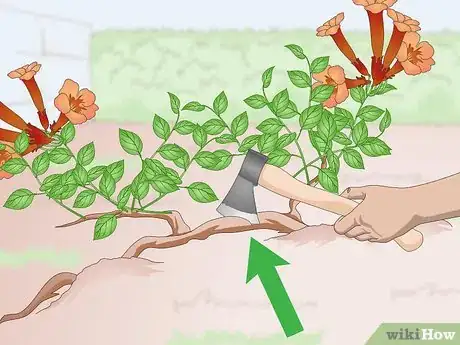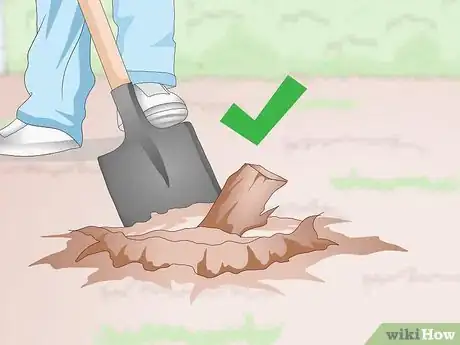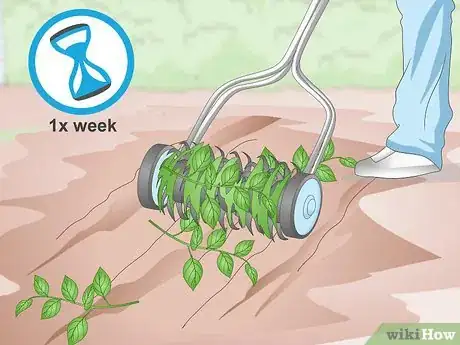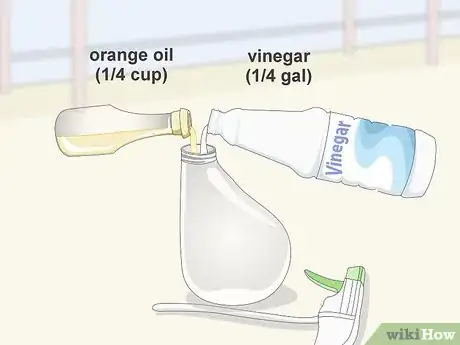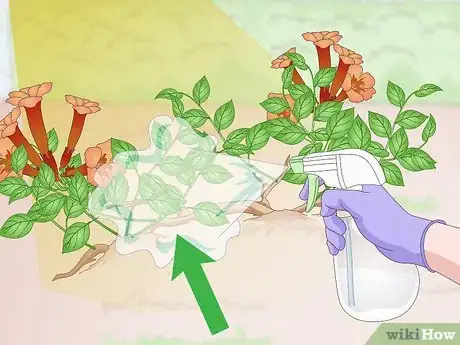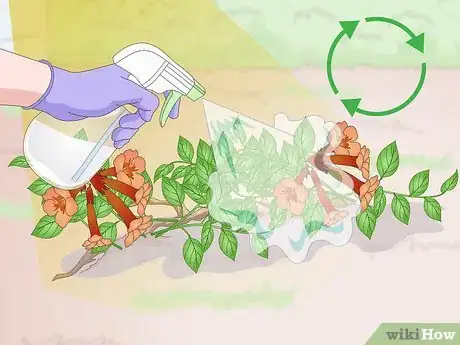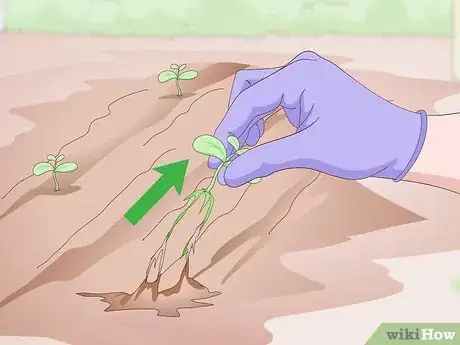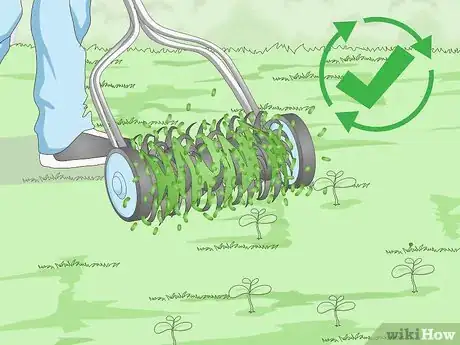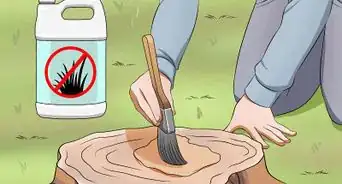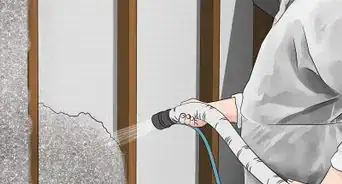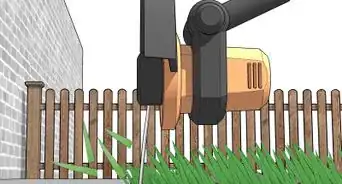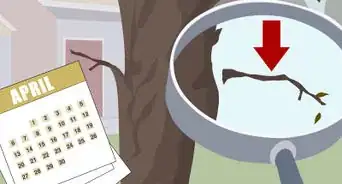This article was co-authored by Maggie Moran. Maggie Moran is a Professional Gardener in Pennsylvania.
This article has been viewed 56,824 times.
Trumpet vine, which is native to the southeastern United States, can be very hard to kill once its root system is in the ground. However, with persistence and patience, you can eventually kill the plant by chopping and digging up the roots. Treat any remaining roots with boiling water or an herbicide over the course of a few months, or until the vine dies.
Steps
Chopping and Digging up the Roots
-
1Chop large roots with an ax. Identify the vine’s thickest roots above ground. Use an ax to chop the roots down to a stump. To chop the roots down to their stumps, you may need to chop or cut smaller vines and foliage as well.[1]
- Wear gardening gloves and a long-sleeved shirt to protect your hands and arms while you chop the vine down.
-
2Place roots and foliage in garbage bags. Make sure to pick up any flowers, seedpods, and pieces of vine off of the ground to prevent regrowth. If they are left on the ground, the vine may re-seed itself and start growing again.[2]Advertisement
-
3Use a shovel to dig up small stumps. If some of the stumps are small enough to dig up from the ground, do so. Use a shovel to dig around the stump to expose it. Chop any roots attached to the stump with an ax. Use a garden pitchfork to pull the stump out of the ground. Place the stumps in the trash bag.[3]
Treating the Roots
-
1Drill 2 to 3 holes into the stumps that are left behind. Some of the stumps may be too large to dig up from the ground. Using a drill, place 2 to 3 holes into the stump.[4]
-
2Pour boiling water into the stumps if desirable plants are nearby. If the vine is growing near desirable plants and trees, use boiling water to kill the root system. Boil 6 to 8 cups (1.4 to 1.9 l) of water in a pot on the stove. Pour the boiling water into the stumps to damage the root system.[5]
- You will need to continue this treatment every 4 to 6 weeks for several months to kill the vine completely.
-
3Apply an herbicide to the stumps if desirable plants are not nearby. Pour a full strength herbicide like Round Up, Rodeo, Pathfinder II, or Triclopyr 3 into the stumps. Apply the herbicide per the instructions on the bottle. Retreat any regrowth with the herbicide after 6 weeks.
- If trees and plants are nearby but you still want to use an herbicide, Round-Up and Rodeo are less invasive than Pathfinder II and Triclopyr 3.
- You can find these herbicides at your local gardening store.
-
4Mow your lawn once a week until the vine is dead. As you attempt to kill the large roots, the vine will start growing smaller shoots to keep itself alive. Mowing your grass once a week will keep smaller shoots at bay while you attempt to kill the larger roots.[6]
-
5Cover the stumps with mulch once the vine is finally dead. The mulch will help suffocate any remaining roots that are still under the ground. You can also cover the area with soil, cardboard, or something thick that will block sunlight.[7]
Using Vinegar and Orange Oil
-
1Prepare a mixture of high acidity vinegar and orange oil in a spray bottle. Combine 1⁄4 gallon (0.95 L) of 20-percent acidity vinegar and 1⁄4 cup (59 mL) of orange oil in a large spray bottle.
- You can find high acidity vinegar online or at your local home improvement store.
-
2Spray the trumpet vine with the mixture on a hot, clear day. Don’t spray the vine if it has rained recently or if the forecast is calling for rain, or the mixture could wash away. Make sure you completely cover the vines, roots, and stumps of the plant with the mixture.
- Wear protective gloves and eyewear when you’re spraying the plant.
-
3Repeat if the trumpet vine doesn’t die after one application. It may take more than one application of the vinegar and orange oil mixture to kill the trumpet vine. Wait for a hot, clear day to apply the mixture again.
Identifying and Preventing New Trumpet Vines
-
1Look for green, leaf-like shoots growing from the ground. Trumpet vine spreads itself above ground and below ground. Keep the vine from expanding above the ground by immediately removing the new shoots that sprout through the soil.[8]
-
2Remove new shoots from your garden and flower bed with your hands. Wear gardening gloves to do this. Pull the new shoots up and out of your garden or flower bed. For stubborn shoots, use a garden hoe to pull them out of the ground.[9]
-
3Keep mowing frequently to remove shoots from your lawn. Regular mowing helps prevent an old trumpet vine from re-emerging, and also helps stop a new vine from taking off. Mow your lawn once every 7 to 10 days.[10]
Expert Q&A
Did you know you can get expert answers for this article?
Unlock expert answers by supporting wikiHow
-
QuestionHow do trumpet vines spread?
 Lauren KurtzLauren Kurtz is a Naturalist and Horticultural Specialist. Lauren has worked for Aurora, Colorado managing the Water-Wise Garden at Aurora Municipal Center for the Water Conservation Department. She earned a BA in Environmental and Sustainability Studies from Western Michigan University in 2014.
Lauren KurtzLauren Kurtz is a Naturalist and Horticultural Specialist. Lauren has worked for Aurora, Colorado managing the Water-Wise Garden at Aurora Municipal Center for the Water Conservation Department. She earned a BA in Environmental and Sustainability Studies from Western Michigan University in 2014.
Professional Gardener
-
QuestionAre trumpet vines poisonous to humans?
 Lauren KurtzLauren Kurtz is a Naturalist and Horticultural Specialist. Lauren has worked for Aurora, Colorado managing the Water-Wise Garden at Aurora Municipal Center for the Water Conservation Department. She earned a BA in Environmental and Sustainability Studies from Western Michigan University in 2014.
Lauren KurtzLauren Kurtz is a Naturalist and Horticultural Specialist. Lauren has worked for Aurora, Colorado managing the Water-Wise Garden at Aurora Municipal Center for the Water Conservation Department. She earned a BA in Environmental and Sustainability Studies from Western Michigan University in 2014.
Professional Gardener
-
QuestionHow do you trim a trumpet vine?
 Lauren KurtzLauren Kurtz is a Naturalist and Horticultural Specialist. Lauren has worked for Aurora, Colorado managing the Water-Wise Garden at Aurora Municipal Center for the Water Conservation Department. She earned a BA in Environmental and Sustainability Studies from Western Michigan University in 2014.
Lauren KurtzLauren Kurtz is a Naturalist and Horticultural Specialist. Lauren has worked for Aurora, Colorado managing the Water-Wise Garden at Aurora Municipal Center for the Water Conservation Department. She earned a BA in Environmental and Sustainability Studies from Western Michigan University in 2014.
Professional Gardener
References
- ↑ http://www.weekendgardener.net/blog/2014/07/how-to-kill-trumpet-creeper.htm
- ↑ https://ask.extension.org/questions/150233
- ↑ http://www.weekendgardener.net/blog/2014/07/how-to-kill-trumpet-creeper.htm
- ↑ http://www.weekendgardener.net/blog/2014/07/how-to-kill-trumpet-creeper.htm
- ↑ http://www.weekendgardener.net/blog/2014/07/how-to-kill-trumpet-creeper.htm
- ↑ http://www.weekendgardener.net/blog/2014/07/how-to-kill-trumpet-creeper.htm
- ↑ http://www.weekendgardener.net/blog/2014/07/how-to-kill-trumpet-creeper.htm
- ↑ https://nature.mdc.mo.gov/discover-nature/field-guide/trumpet-creeper-trumpet-vine
- ↑ http://articles.chicagotribune.com/2011-02-10/features/ct-sun-garden-0213-qa-trumpet-20110210_1_trumpet-vine-vine-blooms-aggressive-vine
About This Article
Trumpet vines can be tough to kill, but you can safely get rid of them by destroying their root systems. Start by chopping any large roots above the ground with an ax. Put all the pieces of the vine in a bag and dispose of it so the vines don’t start to grow again. If the vines have a small stump, you may be able to dig it out with a shovel. If it’s too big to dig out, drill a few holes in the stump and pour boiling water inside to kill the roots. Do this once a month until the roots are completely dead. Then, cover the stump with mulch, soil, or cardboard, which will suffocate any surviving or new roots. For more tips from our Gardening co-author, including how to make a vinegar and orange oil spray to kill trumpet vines, read on!
